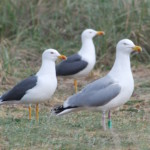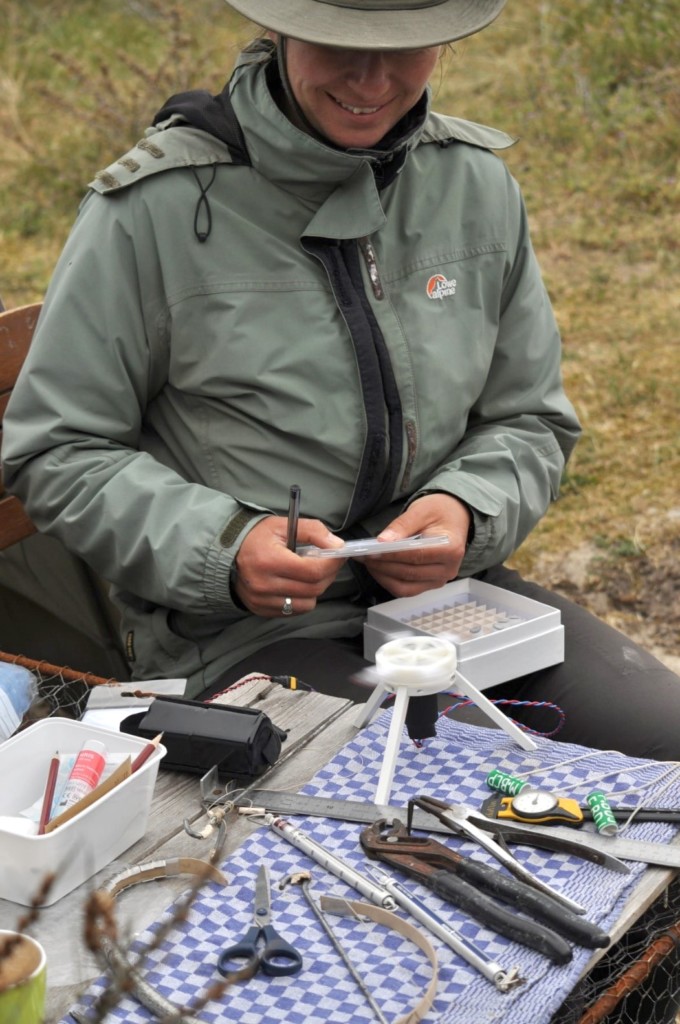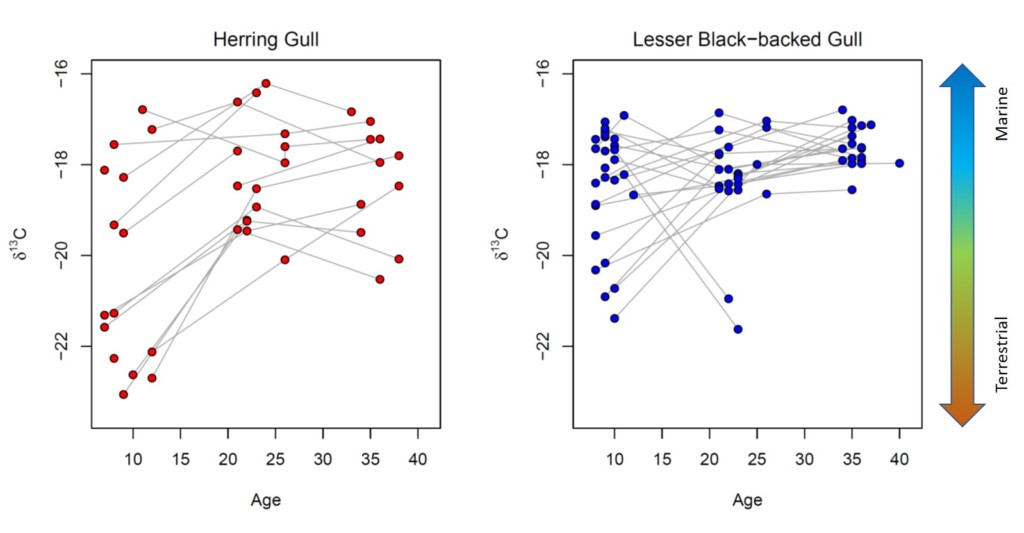Report from a BOU-funded project
 Generalist species have, in principle, a wide range of food to choose from. Herring Gulls (Larus argentatus) and Lesser Black-backed Gulls (Larus fuscus) breeding in the Netherlands are known to forage at sea, on farmland and on human waste. However, individuals within these species are more or less specialised on certain food types (Camphuysen et al., 2015; van Donk et al., 2019). Some gulls that forage in cities hardly forage at sea, and the other way around.
Generalist species have, in principle, a wide range of food to choose from. Herring Gulls (Larus argentatus) and Lesser Black-backed Gulls (Larus fuscus) breeding in the Netherlands are known to forage at sea, on farmland and on human waste. However, individuals within these species are more or less specialised on certain food types (Camphuysen et al., 2015; van Donk et al., 2019). Some gulls that forage in cities hardly forage at sea, and the other way around.
Upgrowing young might have different energy and nutrient requirements than adults. Based on regurgitates, van Donk et al. (2017) discovered that Herring Gulls’ chicks that were fed fishery discards or domestic refuse have higher survival rates than those fed coastal bivalves or food found on farmland. Sotillo et al. (2019) found that Lesser Black-backed Gulls’ chicks fed terrestrial-based food developed at a slower rate, although likely because the quantity was limited instead of quality.
When my partner and I became parents, we adapted our meals; less salty, less spicy, and in general healthier food, because we wanted nothing but the best for our offspring. Do gulls also adapt their foraging to match the energy and possibly nutrient requirements of their chicks? To answer this question, we studied the diets of adults and chicks with Stable Isotope Analysis (SIA), with the help of a BOU research grant.
The ratio of stable isotope values of tissues can reveal what they have eaten when this tissue was created. For instance, Carbon (C), the basis of all organic material, exists in different forms: two stable isotopes (12C and 13C) and a radioactive isotope (14C). With SIA we measure the ratio of 12C and 13C. This ratio, δ13C, differs for food originating from land and from sea (Fry, 2006). Another stable isotope ratio we measured, δ15N, indicates the trophic level of the ingested food. Therefore, analysing both stable isotopes, we can get an idea of where the food came from, although it is not possible to know what they have eaten exactly.
To measure stable isotope ratios of adults and chicks of Herring and Lesser Black-backed Gulls, we took blood samples. These blood samples were separated into red blood cells and plasma by centrifuging the samples, which we did in the field by a custom-made field spinner (Figure 1). Plasma has a quicker turn-over-rate than red blood cells, thereby indicating diet of approximately the past four days, while red blood cells indicate the diet of approximately the past four weeks (Hobson & Clark, 1992). Adults were captured with walk-in-traps while incubating eggs, and a subset of chicks which we followed closely was captured at 10 days old, 22 days old and 35 days old to assess change during growth.
 Figure 1 Spinning blood with our custom-made field spinner (Photo: Kees Camphuysen)
Figure 1 Spinning blood with our custom-made field spinner (Photo: Kees Camphuysen)
Adults of both Herring Gulls and Lesser Black-backed Gulls show a wide range of stable isotope ratios (Figure 2a). Those in the top right corner are individuals which had a marine diet. Lesser Black-backed Gulls had a higher δ15N than Herring Gulls, indicating they forage on prey of higher trophic level. Indeed, Herring Gulls on Texel are often found foraging on mussels on breakwaters (van Donk et al., 2019) while Lesser Black-backed Gulls with a marine diet are out at sea, following fishing vessels or catching pelagic fish (Tyson et al., 2015). Those in the left bottom corner were foraging on terrestrial prey, and those in the middle had a mixed diet.
 Figure 2 Stable isotope ratios of Carbon (δ13C) and Nitrogen (δ15N) of (a) adults and (b) chicks of Herring and Lesser Black-backed Gulls. These values are from blood plasma (indicating diet in the last three days). Adults were captured during incubation, values from chicks at three weeks old are shown.
Figure 2 Stable isotope ratios of Carbon (δ13C) and Nitrogen (δ15N) of (a) adults and (b) chicks of Herring and Lesser Black-backed Gulls. These values are from blood plasma (indicating diet in the last three days). Adults were captured during incubation, values from chicks at three weeks old are shown.
Three-week-old chicks of Herring Gulls showed a larger spread in isotopic ratios than chicks of Lesser Black-backed Gulls (Figure 2b), indicating that they received a broader diet. Lesser Black-backed Gull chicks seem to have received mainly fish as food. Interestingly, for both species, the chicks’ diet became more marine when they grew older (Figure 3). Adults thus seem to adapt to the needs of their chicks by providing food with the highest energetic gain (van Donk et al., 2017).
 Figure 3 Change of δ13C in blood plasma of Herring and Lesser Black-backed Gull chicks while they age. Lines indicate individuals and chicks fledge at 40 days.
Figure 3 Change of δ13C in blood plasma of Herring and Lesser Black-backed Gull chicks while they age. Lines indicate individuals and chicks fledge at 40 days.
Understanding what adults and chicks of Herring Gulls and Lesser Black-backed Gulls eat and whether they are able to adapt their foraging is also important in the light of recent anthropogenic changes. The availability of discards is reducing due to changing fishery policies, and landfills are closing down which reduces domestic refuse. To understand the effect of these changes, we will continue to monitor diets and their effects on the development of chicks and how this will change in the years to come.
Funding
Rosemarie Kentie (Postdoc researcher, NIOZ Royal Netherlands Institute for Sea Research, the Netherlands) was awarded a small ornithological grant of £823 in 2019 for a project entitled ‘Family dinner: do parents of Lesser Black-backed and Herring Gulls adapt their foraging behaviour to their chicks’ needs’.
This work was also partly funded by the Academy Ecology Fund 2019 of the Royal Netherlands Academy of Arts and Sciences (KNAW).
References
Camphuysen, K.C.J., Shamoun-Baranes, J., van Loon, E.E. & Bouten, W. 2015. Sexually distinct foraging strategies in an omnivorous seabird. Marine Biology 162: 1417-1428.VIEW
Fry, B. 2006. Stable isotope ecology. Springer
Hobson, K.A. & Clark, R.G. 1992. Assessing avian diets using stable isotopes I: Turnover of 13C in tissues. The Auk 94: 181-188.
Sotillo, A., Baert, J.M., Muller, W., Stienen, E.W.M., Soares, A. & Lens, L. 2019. Recently-adopted foraging strategies constrain early chick development in a coastal breeding gull. PeerJ 7: e7250.VIEW
Tyson, C., Shamoun-Baranes, J., Van Loon, E.E., Camphuysen, K. & Hintzen, N.T. 2015. Individual specialization on fishery discards by lesser black-backed gulls (Larus fuscus). ICES Journal of Marine Science 72: 1882-1891.VIEW
van Donk, S., Camphuysen, K.C.J., Shamoun-Baranes, J. & van der Meer, J. 2017. The most common diet results in low reproduction in a generalist seabird. Ecology and Evolution 7: 4620-4629.VIEW
van Donk, S., Shamoun-Baranes, J., van der Meer, J. & Camphuysen, K.C.J. 2019. Foraging for high caloric anthropogenic prey is energetically costly. Movement Ecology 7: 17.VIEW
Image credit
Top right: Herring Gull (with colour ring) and Lesser Black-backed Gulls in the breeding colony (Photo: Rosemarie Kentie)




